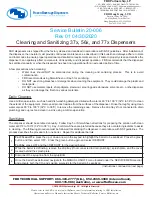
3
The dispenser is for indoor use only. This unit is not a toy. Children should be supervised not to play with appliance. It should not
be used by children or infirm persons without supervision. This appliance can be used by children aged from 8 years and above
and persons with reduced physical, sensory or mental capabilities or lack of experience and knowledge if they have been given
supervision or instruction concerning use of the appliance in a safe way and understand the hazards involved. Cleaning and
user maintenance shall not be performed by children without supervision. The min/max ambient operating temperature for the
dispenser is 40°F to 105°F (4°C to 41°C) at a max altitude of 16,400 ft (5,000 m). Do not operate unit outside these conditions.
Should freezing occur, cease operation of the unit and contact authorized service technician. Service, cleaning, and sanitizing
should be accomplished only by trained personnel. During installation, old hose sets should not be reused to connect the unit to
the water mains; new hose sets should always be used. Applicable safety precautions must be observed. Instruction warnings on
the product being used must be followed.
!
Intended Use
Check the dispenser nameplate label, located behind the splash plate, for the correct electrical requirements of unit.
Do not plug
into a wall electrical outlet unless the current shown on the serial number plate agrees with local current available. Follow all local
electrical codes when making connections. Each dispenser must have a separate electrical circuit. Do not use extension cords
with this unit. Do not ‘gang’ together with other electrical devices on the same outlet.
Do not locate multiple portable socket-out-
lets or portable power supplies at the rear of the appliance.
The key-switch does not disable the line voltage to the transformer
primary. Always disconnect electrical power to the unit to prevent personal injury before attempting any internal maintenance. The
resettable breaker switch should not be used as a substitute for unplugging the dispenser from the power source to service the
unit. Only qualified personnel should service internal components of electrical control housing. Make sure that all water lines are
tight and units are dry before making any electrical connections!
F
Electrical Warning
•
Carbon Dioxide (CO
2
) is a colorless, noncombustible gas with a light pungent odor. High percentages of CO
2
may displace
oxygen in the blood.
•
Prolonged exposure to CO
2
can be harmful. Personnel exposed to high concentrations of CO
2
gas will experience tremors
which are followed by a loss of consciousness and suffocation.
•
If a CO
2
gas leak is suspected, immediately ventilate the contaminated area before attempting to repair the leak.
•
Strict attention must be observed in the prevention of CO
2
gas leaks in the entire CO
2
and soft drink system.
5
Carbon Dioxide (CO
2
) Warning
CO
2
cylinders should only be handled by trained personnel who are aware of the hazards associated with CO
2
gas. CO
2
cylinders
should be handled with care. Never drag or drop a CO
2
cylinder. Never attempt to handle a leaking CO
2
cylinder. The valve should
always be closed when handling a cylinder. If the cylinder is fitted with a valve cap, always verify the cap is secure before handling.
Always store CO
2
cylinders in an upright position and in a well-ventilated area. Never store CO
2
cylinders near anything that emits
high heat and keep out of direct sunlight. Enclosed areas in which CO
2
is being stored should be equipped with a CO
2
monitoring
system.
5
CO
2
Safe Handling and Storage
Provide an adequate potable water supply. Water pipe connections and fixtures directly connected to a potable water supply
must be sized, installed, and maintained according to federal, state, and local laws. The water supply to the carbonator must be
at least a 3/8 inches (9.525 mm) pipe with a minimum of 40 psi (0.276 MPa) line pressure, but not exceeding a maximum of 80
psi (0.552 MPa). Water pressure exceeding 80 psi (0.552 MPa) must be reduced to 80 psi (0.552 MPa) with pressure regulator.
The water supply to non-carb drinks must be a minimum of 40 psi (0.276 MPa), using a water booster if needed. Use a filter in
the water line to avoid equipment damage and beverage off-taste. Check the water filter periodically, as required by local condi-
tions. The water supply must be protected by means of an air gap, a backflow prevention device or another approved method to
comply with NSF standards. A leaking inlet water check valve will allow carbonated water to flow back through the pump when it
is shut off and contaminate the water supply. Ensure the backflow prevention device complies with ASSE and local standards. It
is the responsibility of the installer to ensure compliance.
!
Water Notice
The dispenser should only be installed in a location where it can be overseen by trained personnel, and it should never be
installed in an area where a waterjet can be used.
NOTE




































